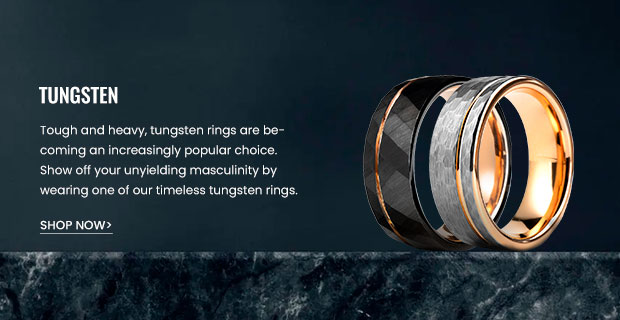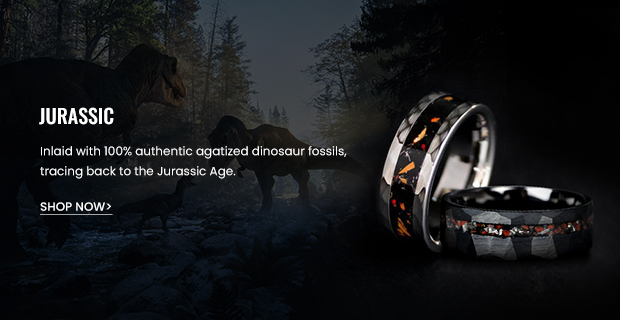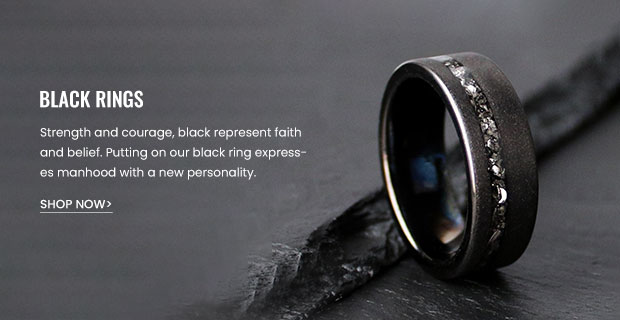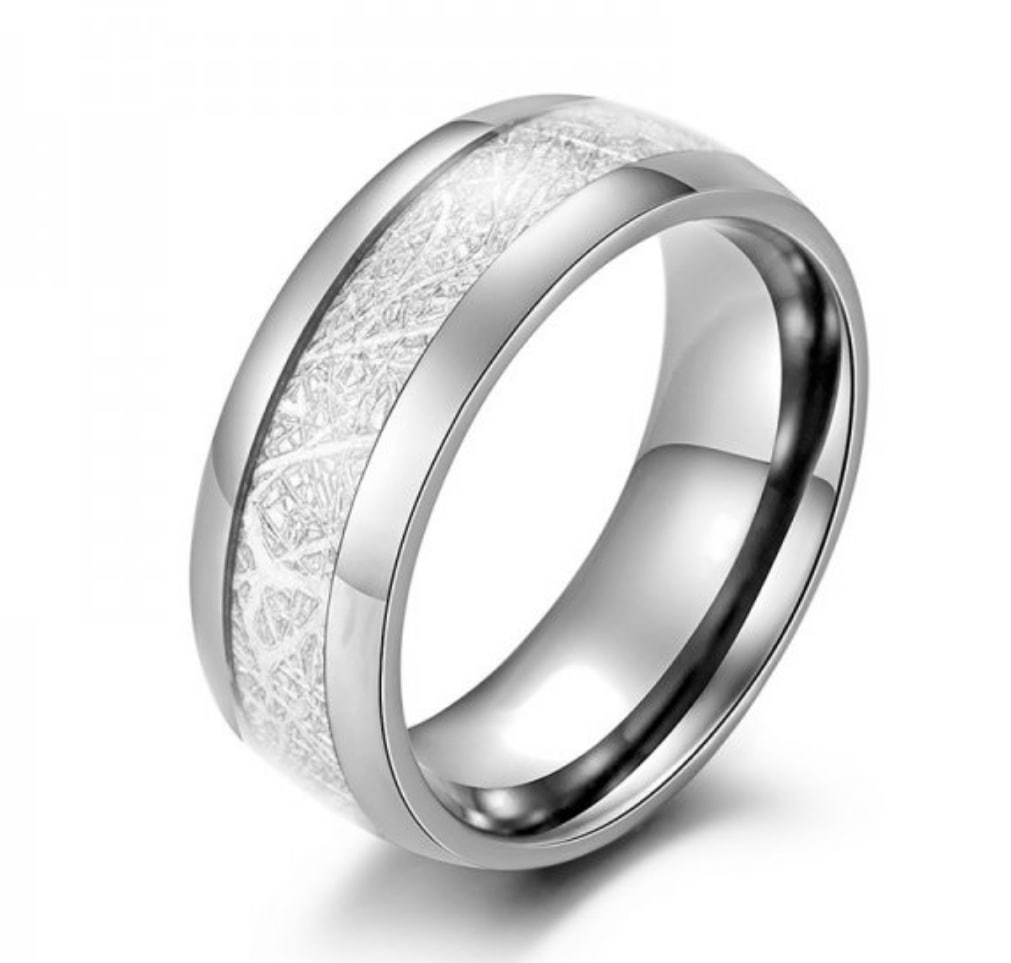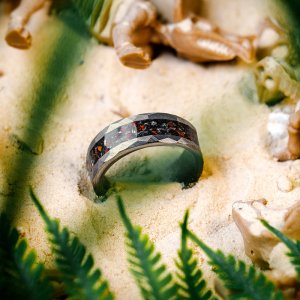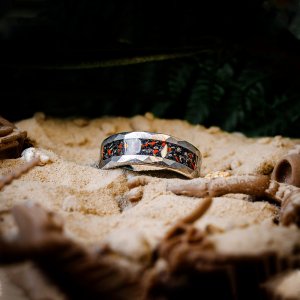A meteorite is a piece of rock that falls to earth after traveling millions of years in space. They form the phenomena known as the shooting star as they fall from outer space and hit our atmosphere.
Being exceptionally rare, they have also become a popular pick for wedding and engagement rings. We can take the example of the gibeon meteorite ring.
What is a Meteorite Ring made of
Even in the already rare meteorite rocks, there are further rare classifications. More than 90% of meteorite found on earth has a stony body with a lot of texture and bumps.
Most meteorite rings are made of the rare 5% of meteorites that contain high amounts of iron and nickel with tiny bits of cobalt. These are exceptionally durable and last for a lifetime.
Besides these, the exact contents of a meteorite wedding ring also depend on the particular meteorite you opt for. Gibeon is mostly iron, while Lunar meteorites can have a stony-iron build which is present in only 1% of all meteorites.
Types of Meteorite Rings
Gibeon Meteorite
Gibeon is the most commonly used meteorite jewelry. It received its name from a Town in Namibia named Gibeon— where the meteorite was first discovered. It stands out due to the variety of outer space elements it embeds, particularly the high levels of nickel, cobalt and phosphorus.
Because of its high inclusion, the meteorite usually forms distinct geometric patterns that create a speckled and modern look. Gibeon Meteorite rings pair beautifully with high-end metals like gold or platinum while remaining the focal point.
Muonionalusta Meteorite
Like Gibeon, Muonionalusta also gets its name from the town of discovery, this time a small Finnish town. Muonionalusta rings stand out due to their subtler colors and are a popular choice for their unconventional appearance. This titanium ring has a beautiful vibe.
Due to the high nickel content, they are usually darker and often used for an “all-black” aesthetic. They also have one of the most prominent and interesting Widmanstätten patterns— an inimitable pattern unique to meteorites only.
Lunar Meteorite
Lunar Meteorite rings are the most sought-after due to their point of origin. Being literal bits of the moon, the meteorite has a more inclusive and speckled aesthetic than any other type. They also give one of the most sparkly and artful patterns when polished by craftsmen. Such a wedding band is always luxurious.
Just like the contents of the moon, the composition of lunar meteorites is also diverse. This leaves more variety of colors, patterns, styles, and contrasts to choose from.
While tastes and preferences exceptionally vary with personalities, Lunar Meteorite rings seem like the perfect gift for someone who likes some extra bling.
Pros and Cons of Meteorite rings
Meteorite rings are easy to incorporate into a wide variety of band styles, colors, and wedding themes. They can be made to give off an earthly and subtle feel or turned into a sophisticated and shiny piece of bling.
But with such a long-term purchase, the functionality, maintenance, and durability also become important questions. Iron meteorites are specifically durable.
Here is a full breakdown of the benefits and trade-offs associated with a meteorite ring.
The Benefits
- Meteorite rings are priced more reasonably than other rings made with rare stones and metals.
- They are rarer than platinum, gold, and even some types of diamonds yet remain a more affordable option for high-stake events like weddings.
- These rings allow you to add a lot of your own personality to the design. Because of the variety of inlays, contrasts, and colors of different meteorites, finding one that checks all the boxes is incredibly effortless.
- They allow the type of customization for inlays and complementary materials that diamonds or other rings don’t.
- The strong blend of iron and nickel give the meteorite engagement ring a hard, non-porous, and incredibly durable body. This also makes them resilient when it comes to long-term wear and tears.
- Moreover, when coated with the right finishing, they are easily made rust, corrosion, and degradation free, just like any other expensive jewelry.
Meteorites travel millions of years in space before they find their way to the earth’s atmosphere. During this time, they develop unique patterns that are unique to them.
Such intricate patterns are not easily emulated with even modern techniques. Etching and Grooving on metal and stones isn’t easy even with modern machinery.
For this reason, when you buy a meteorite wedding ring, it will be as unique as your fingerprint and something that will never be replicated again.
The Trade-offs
- Meteorite rings can be a little high maintenance if proper polishing and a high-quality build are not present. Because of their high iron content, they are exceptionally prone to rust and corrosion.
- You may have to take them off and keep them safe somewhere else throughout the day. Activities like swimming or using sauna can result in moisture entering the meteorites. If not cleansed and wicked away in time, the moisture can result in rusting.
- They also need to be cleaned regularly (unless there is a nice polish) with a toothbrush or similar materials to keep dirt away. This is because meteorites often have tiny bumps and textures when in their natural form.
How to Identify Authentic Meteorite Ring
Meteorite rings can hold a lot of sentimental value for you. Being so rare, they are costly and prone to misleading marketing like any other high-end jewelry.
Here are some of the ways you can quickly test the authenticity of your meteorite ring:
Magnetism test
99% of all meteorite material is highly magnetic due to the high presence of iron and nickel. Simply placing a small magnet against the ring should result in a strong attraction.
Even a ring with low iron or overall low metal contents will also attract the magnet. The test helps you do a double-layer authenticity test when the results from a rusting test are negative. It can be more helpful because certain meteorites such as Gibeon and Seychman are naturally rust-free.
Many guides advise on testing for rusting or potential for rust. Some also suggest that soaking them in harsh chemicals or acidic solutions will reveal their authenticity.
However, how many of us really want to destroy a nice and expensive meteorite ring just to test its authenticity? It’s also important to remember that testing for Rusting potential is a double-edged sword. This is because so many materials other than meteorites can also have the potential to rust.
A magnetic test can be the all-rounder solution in such a case.
Vulnerabilities of Magnetism Test
In some cases, the surrounding base of your meteorite ring can attract the magnet, resulting in a false negative. The best way to compensate for this is by using a smaller magnet and looking closely at how the ring reacts when the magnet is placed at different angles.
It’s important to know that many other earth metals also hold magnetic properties. To rule out the possibility of these metals, you can also do a different set of compensatory tests.
You can start by looking for the Widmanstätten Pattern. This is not a specific pattern that you have to cross-check with other meteorites.
In fact, it is the randomness, inclusions, and lack of uniformity that makes it the original Widmanstätten Pattern. Creating deep and sophisticated marks is not easy when it comes to designing, molding, and etching metal. This makes the Widmanstätten pattern harder to fake.
If your meteorite looks like it has been through a lot of wear and tear and has random patterns of scratches with varying lengths and widths, it is most likely authentic.
Meteorite Ring Creation Process
Because of their intricate nature, inlaying meteorites within a ring band is a long but beautiful process.
Throughout its journey, the tiny slab of the meteorite is handled with care and molded carefully so the space-created patterns can be preserved. Some of the steps the ring goes through are described below.
- The supporting base of tungsten or other paired metals is melted and molded into different ring sizes.
- A tiny slab of the meteorite is carefully cut to the exact length needed for molding. The process of molding can be different depending on the contents within. Usually, a lathe machine is used to shape and expand the ring as needed.
- The slab is then trimmed for a more modern appearance and polished to bring out the shine. The rounded shape is then placed on a turning and grinding device known as the Mandrel. This holds the ring in place as craftsmen work on the final etching, treatments, and finishing.
- The patterns and inclusions on the meteorite are made more prominent with the help of deliberate polishing. This is the most important part of a meteorite ring’s creation as it determines the final color, clarity, shape, and shine.
- In cases of Inlay Rings, the overall metal band is molded to have a round indent where the meteorite is placed and sealed.
What to Look For When Choosing a Band
Type of Metal
Platinum, Titanium, and Tungsten are the most popular metals for the base of meteorite rings. The type of metal you pick will determine how much the meteor element stands out and the final look it creates.
Color can also play an important role. For example, black carbine tungsten can really help the meteorite pattern shine with its bold yet subtle aesthetic. In contrast, the silvery appearance of titanium can be more suitable if a darker meteorite is used.
Width of Ring
This is an often-overlooked aspect. Ranging from 1mm to over 8mm, there is a high possibility of finding the exact wanted width in a lot of variety. Something bigger can make your ring pop more, but your finger may grow tired of wearing it all the time.
Your best choice might be something between 2 to 4 mm, as they are right in the middle of the spectrum.
Authenticity
Meteorite rings are often faked on the market just like any other high-end piece of jewelry. You should opt for a trustworthy vendor that has a proven track record of authenticity.
Most high-quality vendors also promise a lifetime or similar warranty. Besides this, an authentic ring will likely come with a certification of authenticity. However, this isn’t always the case.
How to Care for a Meteorite Ring
Although Meteorites are vulnerable to acidic solutions, water, and harsh chemicals, the rings aren’t.
Most of the meteorite rings on the market promise degradation-free longevity. This is because the chances of water, chemicals, salt, and other materials entering the sensitive meteorite are eliminated with the thick polishing.
However, you still need to learn some maintenance practices if your meteorite is raw and natural.
Make sure to:
- Occasionally soak the ring in rubbing alcohol
- Take the ring off when showering or washing dishes
- Keep the ring away from dish soap, and other cleaning solutions
- Seal the meteorite with wax or oil to prevent moisture buildup
Final words
Buying any piece of jewelry can be sentimental and of great importance. It’s important to go with your own style and preferences rather than focusing on trends.
You should do your own research, look at a lot of designs, and give your decision-making some time. Given that meteorites can be quite costly, the decision should never be rushed.
With this in mind, the design should not be a reason to compromise on the overall quality and authenticity either.

